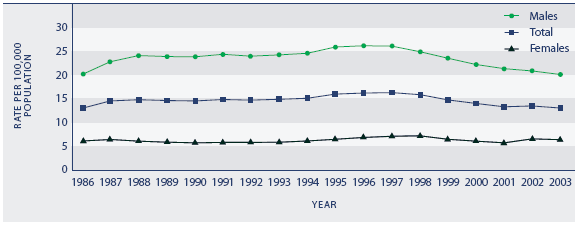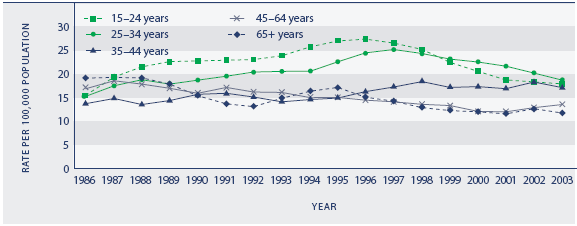Suicide
Definition
The number of suicide deaths per 100,000 population, expressed as a three-year moving average age-standardised rate, for the population aged 5 years and over.
Relevance
Suicide is an indicator of the mental health and social wellbeing of society and a major cause of injury-related death in the population.
Current level and trends
In 2004, 486 people died by suicide, a decline from the 517 people who died in 2003.20 The three-year moving average age-standardised21 suicide death rate was 13.1 per 100,000 population in 2002–2004, compared with 13.5 per 100,000 in 2001–2003. Over the 1980s and 1990s there was an upward trend in the suicide death rate, which reached a peak of 16.3 per 100,000 in 1995–1997 and 1996–1998. Since then the rate has fallen and the 2002–2004 rate was the same as the 1985–1987 rate of 13.1 suicide deaths per 100,000 people.
Figure H3.1 Age-standardised suicide deathrate, three-year moving average, by sex, 1985–2004

Source: Ministry of Health, New Zealand Health Information Service
Notes: (1) The three-year moving average rates are plotted on the mid-point year (eg 2003 is the mid-point year of 2002–2004) (2) 2004 figures are provisional (3) Age-standardised to WHO standard population
Age differences
People aged 25–34 years had the highest three-year moving average suicide death rate in 2002–2004 (18.5 per 100,000 population, with 94 deaths in 2004), followed by people aged 15–24 years (17.7 per 100,000, with 112 deaths in 2004).
Figure H3.2 Suicide death rate, three-year moving average, by age, 1985-2004

Source: Ministry of Health, New Zealand Health Information Service
Notes: (1) Age-specific three-year moving average rates, plotted on the mid-point year (eg 2003 is the mid-point year of 2002–2004) (2) 2004 figures are provisional
For many decades, the suicide death rate was consistently highest at ages 65 years and over but this changed in the late 1980s during a steep increase in youth (15–24 year olds) suicide. The youth suicide death rate peaked at 27.2 per 100,000 people aged 15–24 years in 1995–1997. It has fallen by 35 percent since then, but is still higher than the 1985–1987 rate of 15.8 per 100,000. The pattern is similar for 25–34 year olds. Suicide death rates have been falling among people aged 45 years and over. These age patterns may reflect, in part, cohort effects.
Sex differences
Males have a much higher rate of death by suicide than females, with 20.1 deaths per 100,000 males in 2002–2004, compared with 6.4 deaths per 100,000 females.22 The male suicide rate increased sharply in the late 1980s, declined after 1996–1998, and in 2004 was almost the same as the 1985–1987 rate of 20.3 deaths per 100,000 males. In comparison, the female rate has been relatively stable over the last 20 years. Because of the small numbers involved, it is more reliable to consider the trend over several years.
While the suicide death rate is higher for males, more females than males are hospitalised for intentional self-harm. In 2005, the female–male ratio for intentional self-harm in New Zealand was 2.0 female hospitalisations to every male hospitalisation per 100,000 population. Females more commonly choose methods that are less likely to be fatal.23
Ethnic differences
In 2004, there were 110 Māori deaths from suicide, accounting for 23 percent of all suicide deaths in that year. The three-year moving average age-standardised rate of suicide deaths in 2002–2004 was 17.1 per 100,000 population for Māori, compared to 12.0 for non-Māori. The suicide death rate for Māori youth (15–24 year olds) in 2002–2004 was 32.3 per 100,000, compared with the non-Māori rate of 14.3 per 100,000. Suicide death rates for both Māori and non-Māori – all ages and youth – were lower in 2002–2004 than in 1996–1998. Because of the small numbers, trends in Māori suicide rates should be treated with caution.
International comparison
A comparison of the latest age-standardised suicide death rates in 14 OECD countries between 2001 and 2004 shows New Zealand's (2003) rate was the fourth highest for males (21.0 per 100,000 males) and the fourth highest for females (7.5 per 100,000 females).24 Finland had the highest male suicide death rate (31.1 per 100,000 in 2004), while Japan had the highest female rate (10.4 per 100,000 in 2004). Australia (17.6) had a lower rate of male suicide deaths than New Zealand, as did Canada (18.4) and the United States (18.0). The United Kingdom had the lowest male suicide death rate (10.8). Canada (5.3), Australia (4.8), the United States (4.2) and the United Kingdom (3.2) all reported lower female suicide death rates than New Zealand.
New Zealand had the third highest male youth (15–24 years) suicide death rate, after Finland and Ireland, and the highest female youth suicide death rate. New Zealand is one of a small number of countries which have higher suicide rates at younger ages than at older ages.25
|


